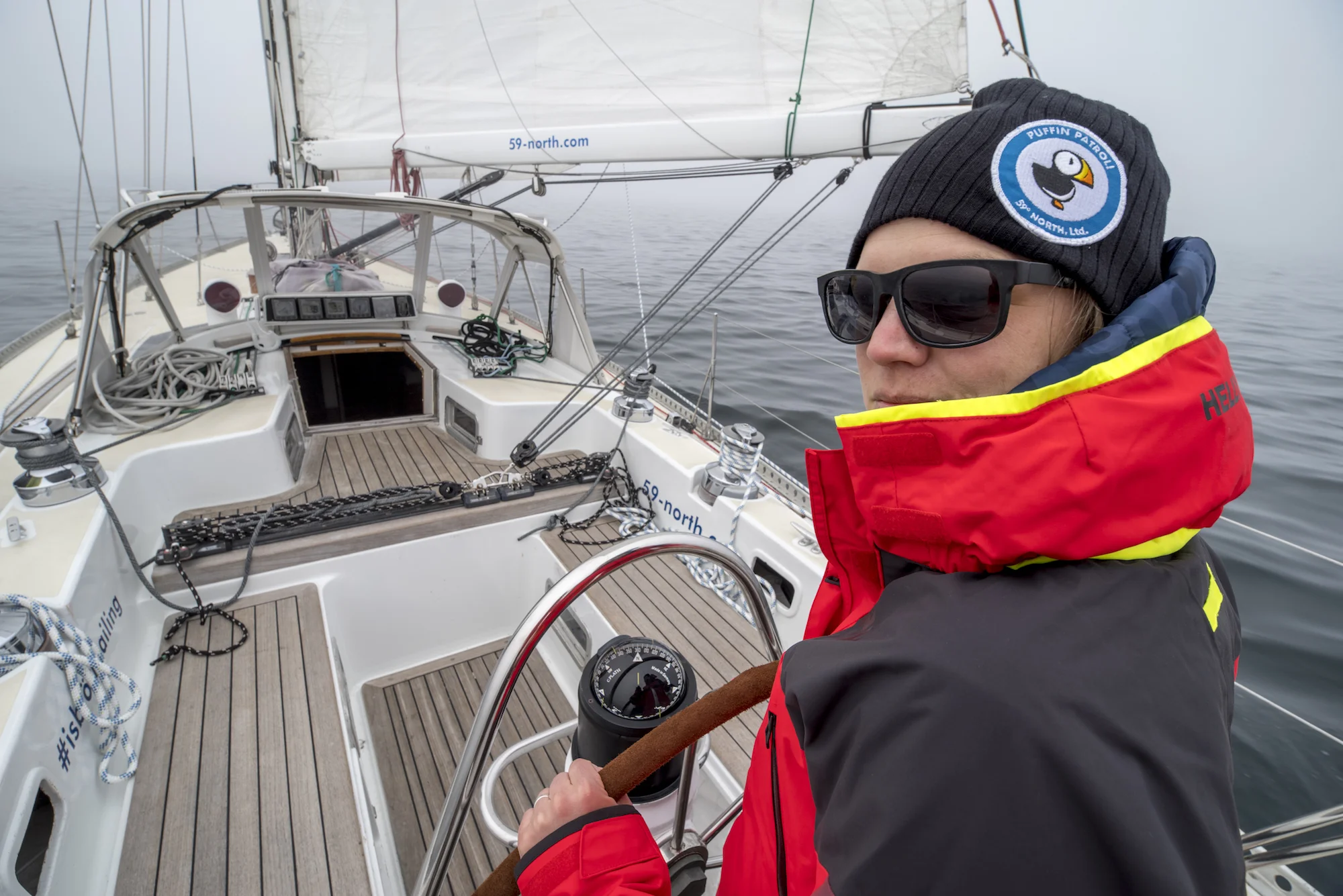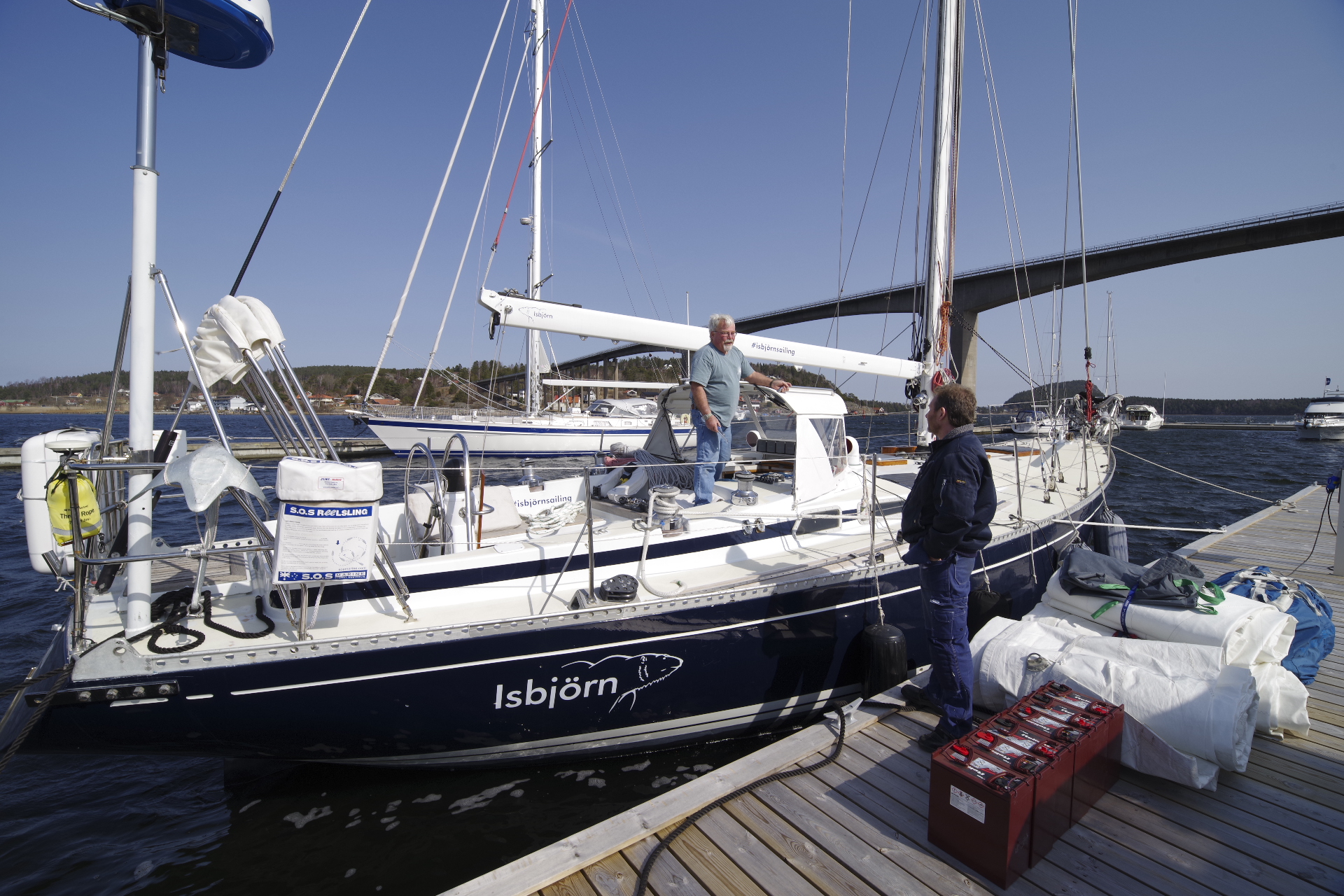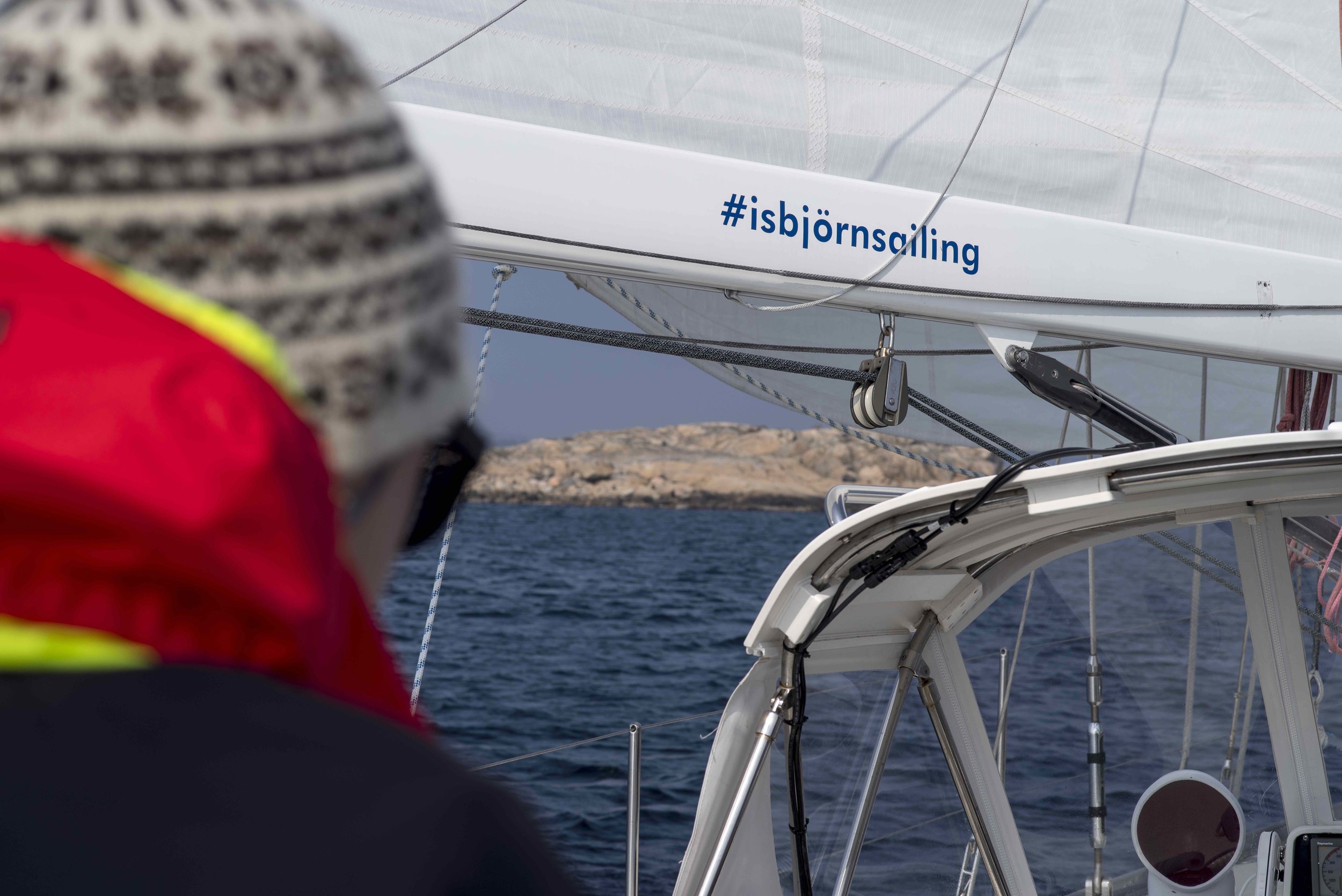Mia at the helm of Isbjorn's first shakedown sail on April 20 in Sweden.
April 24, 2018: I’m writing from the dock in Strömstad, a Swedish summer city on the west coast, just south of the border with Norway. It’s April 24, two weeks to the day since we first moved back aboard the newly refit Isbjörn.
I’ve been hesitant to write anything about the process, mainly because we just haven’t had time. Anybody who commissions a boat in the springtime knows how much work is involved in just getting her liveable, especially when temperatures are still below freezing at night. Then to get her sailable is another level altogether.
-Andy
We moved back aboard on April 10. I’d planned by entire spring around staying home at the farmhouse to watch the Masters golf tournament. It’s my favorite sporting event of the year, and especially so this year with the triumphant return of Tiger Woods. I used to play golf in high school and college, and still follow it closely. I wasn’t going to miss the chance to watch 12 hours of golf for four days straight. It meant we’d have one less week to work on the boat (the yard launched her on March 30), but so be it. We have a long season ahead and I wanted one last weekend to relax.
The week before we loaded up the trailer and took most of the gear we’d removed from Isbjörn in September back to the boat. Since she’d be undergoing some major surgery at Vindö Marin, we wanted to get her an empty as possible, both for the yard’s sake, but also just to keep stuff clean from fiberglass dust, which has a way of getting into everything. That included ALL the cushions, extra lines, the old spinnaker, med kits, tools, dry bags, spices, food containers, all our personal clothing and gear, boots, shoes, books, charts and all the other myriad things that accumulate in a liveaboard, offshore sailing boat. The big items - sails, dinghy, liferaft, drogue, outboard - we stored at the yard in an out of the way place. Mia had also brought home some hanging locker doors, the cockpit table and the dorade boxes to freshen up the varnish. What remained onboard - spare sheets & halyards, a few tools, the sails, blocks and rigging stuff, etc - was packed away into one of the starboard hanging lockers with the door shut.
On the plus side, loading up the trailer with all the stuff we had taken home allowed us to eliminate much of the unnecessary stuff in a very satisfying stint of spring cleaning. Each item we packed in was scrutinized for it’s usefulness and discarded or kept at the house if it was deemed superfluous. We packed only the charts we’d need for this season. We got rid of some old spare lines that had never seen the light of day. We left one of the spinnakers in the attic.
But we added a whole lot too for our arctic summer - 8 very bulky survival suits that needed to find a home aboard; sleeping bags for each of the crew; sweaters, puffy jackets, insulated pants & heavy hiking boots for Svalbard; paper charts and guidebooks for the entire Norwegian coast, Iceland, Faroe, Ireland and Portugal; an updated medical kit with new prescriptions; etc etc.
All this we piled into the trailer and delivered to the boat on April 1, in time to check out the new systems with the yard, add any last minute projects and still get back in time for the Masters.
Tiger didn’t win, but I thoroughly enjoyed a mellow 4 days finishing up packing up the house and watching golf. We drove back to the boat with a car full of more gear and food (Mia had done ALL the dry provisioning for the entire summer), and my dad, who had a big case of FOMO, not wanting to miss out on sailing a newly refit Isbjörn before anyone else, flew to Sweden when we started the recommissioning in earnest, two days after we moved back aboard for good. He was set to stay for 10 days.
The plan was to get the boat ready to sail, then spend a few days heading up the coast and shaking down all the new stuff. Helly Hansen had contacted us to see if we wanted to attend their global sales meeting in Strömstad, which was about 70 miles to the north. The timing was ideal, and we wanted to a longer sail to test the boat off the grid for a while, so we said yes. They’d be sending their US media guy Cam along with us to get some photos of videos. All of a sudden we had a hard and fast deadline, a goal to work towards.
Dad didn't work TOO hard!
Having dad around basically doubled our capacity to get work done. Mia focused on her small projects, which started with sewing a new cover for the bimini when its folded back. Meanwhile dad could lend a hand with all the bigger projects I had to get done.
In the week between us delivering the trailer full of gear and returning to move back aboard, Vindö had finished up their work. The Espar heater has ducting that travels inside the lockers on the port side of the boat, with outlet vents in each cabin and both heads. But the duct work was exposed inside the big storage lockers under the pilot bunk, and vulnerable to gear and food knocking it around in there when heeled. So the yard built an interior bulkhead in each locker to protect it. What we lost in storage space in those huge lockers was gained in comfort several times over (more on the heater itself in a minute). The custom high-output alternator had been giving the yard headaches for a while, so with the help of our guru in the US, Bruce Schwab, they (hopefully) got that sorted out. We also ordered new batteries at the last minute, nervous that of all the things we had refit on the boat, the batteries hadn’t been, and were at least 5 years old and from the old owner, so we bit the bullet and replaced them too.
Carting the sail inventory back to the boat.
Once my dad arrived, we started with just stowing and organizing. We had boxes of stuff in the Vindö storage room, most of which was dry stores with Mia had provisioned while we still had the car. We got the sails down from the Vindö loft, which was a highlight of the week. If you’re near a computer, check out the video of this we posted on the blog. The loft itself is at the top of a huge 4-story building on the waterfront adjacent to the haulout slip. To get up there, you ascend a narrow, steel spiral staircase with a sort of grated, see-through floor. There’s a small catwalk at the top of this with a door to access the loft itself. Next to the building is an enormous crane that they use for stepping and unstepping masts. It’s remote-controlled and electric, so can be run by just one person (incidentally, the Travelift is also remote-controlled and similarly efficient in the use of human labor to run it). Jonas, one of the riggers at the yard, brought our sails out to the catwalk in two big loads, wrapped the lifting strap around them and with his remote control, lowered them down into a big waiting wagon with the crane. Once both lots were loaded up, dad and I wheeled the wagon down the dock and loaded it all onto the boat.
We had ordered new anchor rode to go with the new windlass. We sent the old chain and rope back to the farm with Mia’s dad to use in our gym. Dad & I fitted the new 120-feet of 10mm G40 chain into the chain locker, & shackled it to the big 88-pound Rocna. I’d save the rope-to-chain splice with the new ridiculously oversized 20mm polyester 8-strand plaited rope, for our first excursion out of the dock in a few days.
All this work kind of just hummed along and the days went by. Vindö Marin’s yard is kind of in the middle of nowhere, and we didn’t have a car, so we ate all meals aboard Isbjörn, cooking with the renovated propane system, which as with the other stuff does absolutely nothing differently, just safer and cleaner with all new propane lines run, a sniffer installed and a better sealed box for the regulator and solenoid in the lazarette.
With everything except the dinghy and the drogue out of the storage, we took the opportunity on a cold, foggy & windless day to venture out of the dock, test the engine and alternator, anchor out and test the windlass, run the watermaker, run the heater and live off the grid for a day or two. I’ll admit to being giddy with excitement as we fired up the new Beta 60 and engaged that shiny new throttle lever into forward and motored Isbjörn out of the marina for the first time since September. The motor, like I said, does nothing the old one didn’t, but man does it do it smoother, quieter and with more confidence! The yard did a splendid job on the installation, removing all the old stuff down to the engine beds, cleaning and painting in the bilge and even building a new floorboard back aft to accommodate the larger gearbox. The engine room itself was freshened up with new sound/heat insulation, so now when we open it up, it’s not the black, nasty mess it used to be, but a shiny, spotless little shrine to mechanical machinery.
Once clear of the marina we fired up the watermaker according to the manual’s instruction on commissioning a new unit. With Isbjörn’s old Spectra automatic unit, a simple push of a button on the control panel at the nav station ran the thing for an hour at a press and put it through an automatic flush cycle once the timer ran out on making fresh water. It had built-in sensors that checked the filters and the salinity, automatically diverting the product water into the tank once deemed safe to drink. Being that the unit was probably 15 years old, much of the fancy electrical components had long ago failed. Last season we had to bypass the automatic diversion valve when the salinity sensor failed, and we’ve always had to manually check the filters. Once the salinity sensor went, the simple switch at the control panel didn’t work, so we had to manually switch the unit on at the pump’s override switch.
With the new Cape Horn Extreme model, everything is manual to begin with - there is no control panel, nor are there any sensors. Instead, it’s a simple on/off toggle switch on each of the two redundant feed pumps, a pressure gauge and a manual diversion valve. At startup, the product water is diverted to one of the unused tank vents at the galley sink. We let it run for a few minutes, then test with a simple handheld salinity tester. Anything under 750 ppm, and it’s drinkable, so we throw the diversion valve and send the good water into the tank. Simple as, and we have full control over the system and a visual at a glance on the pressure.
Despite the fog and the cold, that first night at anchor was wonderfully relaxing. Isbjörn was shipshape again, her mended sails back on her spars, everything in it’s place down below and stowed away, and in cruising boat mode again. We got to haul up the anchor the next morning on the new manual 555 windlass, to my delight, and the wash down pump even works better now that we finally got around to putting the correct size breaker on it.
We returned to Vindö the next day to finish loading up the last of the gear, and to install the batteries which had arrived. Dad & I tackled that - it was heavy lifting, literally, taking out 6 of the 6-volt AGM’s, each of which weighed 100 pounds, and replacing them with the same style Trojan 6-volt AGMs which had been delivered to the dock by a forklift on a pallet. I would have loved to do a lithium system, but at this late stage it was easier to replace same with same - the new batteries fit exactly in the same battery box, the wiring was simple and the whole project took only a few hours, with no customization needed. It was a good call too - the new 250-amp alternator plows in the amps on the new battery bank, which is happy to take the power. The old bank was indeed shot, the voltage shooting right up to the limit and not really accepting a charge. Now, with the new batteries and big alternator, we can charge our 900-amp-hour bank from 60% up to 85% - the working range in reality - in under an hour.
Isbjorn's project manager Henrik chatting with my dad. Batteries & sails still on the dock!
We had so much work done by the yard here in Vindö that I had forgotten some of the smaller items, and was pleasantly surprised each time I lifted up a floorboard and saw something they’d done. Like the new sump pump for the shower in the forward head. What once was a rusty, barely working mess, is not a clean, shiny, reliable pump with proper, new hoses attached. In reality, Isbjörn is the same as before, just a better version of herself. Crew who have sailed with us before won’t visually be able to notice any major differences - she still works as before, just a little bit better and cleaner. The old trim tab rudder gear is removed from the bilge, which does nothing at all expect make my soul happier every time I peek down there. The keelboats were dug out, checked, signed off on, and re-sealed. The watermaker is new, still a Spectra, but a manual version of what we had before - still makes fresh water from salt, just hopefully more reliably now. The engine is still putting out 56 horsepower, the alternator still makes electricity, but boy does it look nice in it’s newly insulated engine room! She still has 5 stainless tanks hidden away under the floorboards, but now instead of having to swap out hoses to change them, we just turn a nice shiny red valve.
What is new makes a big difference in living on the boat in a cold wet climate, what we’re going to have from now until September, when we get back into the warm water off Portugal. The new Espar heater is a miracle worker - within 10 minutes of firing it up with the push of a button, the interior of the boat, despite NOT being insulated, is warm enough for bare feet and a t-shirt, even when it’s hovering right around freezing outside. Likewise the hot water heater, which only works when the engine is running, makes showering in the forward head SO MUCH easier!
My dad was rewarded for his hard work in helping us commission the boat at the end of his stay with us when we got to finally go sailing. We left the dock at Vindö for good on Wednesday evening last week, motoring the three miles around the corner to Henån, where we tied up in the guest harbor of the small town and went ashore for a restaurant meal in the only place that was open.
Photo by Helly Hansen's Cam Dini.
Cam Dini from Helly Hansen joined us the next morning and would sail up the coast with us. Just before his arrival, and our departure for points north, Mia had finished up sewing on the new moose hide leather for the steering wheel, which both looks awesome and is almost essential for hand-steering in this cold weather. I went aloft for a quick rig check.
We left the dock around 2pm for Isbjörn’s first one-way voyage of the 2018 season. While motoring down the narrow ten-mile channel inside Orust, I put the finishing touches on the wheel leather with a new hot-pink turk’s head to mark the center spoke which I think contrasts pretty sweetly with the brown moose leather.
Believe it or not, we WANTED fog...to test the new radar!
We hoisted the mainsail once clear of Orust and aimed for Smögen, about 20 miles up the coast and a place I’d always dreamed of sailing to on Isbjörn after having visited there a few summers back by car. We’d attached the mainsail tack backwards, but otherwise it was a smooth set and for the first time since September, we killed the engine and were sailing!
Miraculously, the weather cooperated. We sailed on a light southwesterly, enough wind to keep us moving but calm enough to finish up all the small little projects. The air was thick with fog too, giving us a chance to play with the new Furuno radar in earnest. When we got into Smögenbryggan, which is only about 200-feet wide, we didn’t see the town or the dock until about a boat length away from it. We found the only open restaurant and had a fabulous seafood meal to celebrate Isbjörn’s first shakedown cruise.
Dad on radar watch in the fog with the new Furuno 1835.
Next day the sun was shining, the breeze was up, still from the south, and my spirits were HIGH. We had to take dad and Cam up to the smooth red cliffs just opposite town that make Smögen unique. Isbjörn departed right at 0900 for the last 40 miles to Strömstad.
The sail north was uneventful and wonderful. The work was done, even down to the small details. What’s left is just stuff we WANT to do, but nothing we NEED to do before the season starts in earnest with the arrival of our first crew on May 1. I had time to go aloft and get some photos with my new 15mm wide-angle lens, Cam got some awesome photos and videos for Helly Hansen and we relaxed in the sunshine, broad-reaching on the building southwesterly and hitting over 8 knots at times as Isbjörn did her freight-train thing like only she can. With Mia at the helm and dad on the nav, we threaded our way in through the labyrinthine channels between rocks and skerries that make the sailing in Sweden so unique, and dropped the mainsail, as per usual, at the last possible minute before we hit the dock in Strömstad. Dad flew home from Oslo the next morning, Cam checked into the hotel, and then there was just Mia & I.
In case it wasn’t clear, we are thrilled with the work that the yard at Vindö did. And since we left the boat in September, the business has done so well that I almost wish we had added more projects.
Fingers crossed, everything works, so far. We’re still dialing in the regulator that controls the big alternator, which has a few custom settings to adjust the voltages depending on battery type and specs, but the output of the thing is incredible. We’ve got a lot to learn to get the most out of the new radar. For example, with it’s own dedicated heading sensor, it’s got full ARPA capability and can automatically detect and lock on to targets that represent a potential danger to the boat. I just need to figure out how it all works, and will spend the next few days reading the manual.
In reality, while the new engine, new radar, windlass, etc are all really awesome, the things we like best are what use most often. The new plumbing on the water system, for example - we have foot pumps in both head sinks now, so don’t need to run the pressure pump at all now. And being able to change the valves on the tanks without changing around hoses is a HUGE relief! Having heat when it’s damp to dry out wet clothes is great too. We only run the heater in the morning and evening - overnight, it’s off, and we’re snugged down in our sleeping bags, and plenty warm. We run it over morning coffee to warm up, then again around dinnertime to get the boat cozy before bed. It sips fuel and is quieter than some detractors have made them out to be, and I love it.
I’m going to sleep tight in the Arctic with the new anchor rode. We’ve got a touch more chain now, and the 20mm plaited rope I got is almost ridiculously oversized. I ordered it from a catalog and of course went up a size from what was recommended, not having ever actually seen or touched it. When it arrived I was worried it wouldn’t fit through the chain pipe into the forepeak locker! My dad joked that it looked like a tugboat hawser. Too strong was never a problem though was it?
In case you’re wondering, we spent a grand total of $120,000 on all of this work, and yes, it was worth every penny. Thanks to our incredible crew who continue to sail with us, we were able to pay for it all in cash. All told, we’ve now got my dream boat in my dream condition, and all for less than $300,000 - you’d be hard pressed to find a yacht of Isbjörn’s caliber, of any vintage, outfitted as she is for serious offshore work, for anywhere near that price. We couldn’t be happier.
There will likely be growing pains of course, and while we’re off to a flying start with our first shakedown cruise, I’m still cautious in my optimism and won’t be surprised when something starts acting haywire.
Crew arrive in a week to Marstrand, where we’ll wait for a weather window then set out across the North Sea for Scotland on what will be Isbjörn’s first true shakedown in open water. Follow our progress on 59-north.com/track and wish us fair winds!































